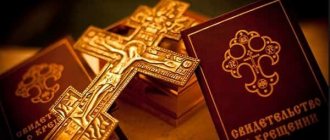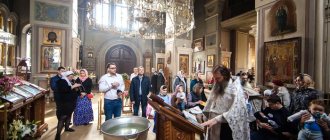It is believed that baptizing a child helps protect the newborn from all evil, as well as take care of his health. In Orthodoxy, when a baby appears in a family, the question is raised about how the child is baptized, rules and signs.
After baptism, many people remove the cross so that the baby does not pull it and the string does not rub the delicate skin. Worn already at a conscious age
Church shop
The best offer on wholesale goods
Buy
We will consider the features of the process of baptism of a newborn, as well as folk signs preserved in the memory of many generations, in our article.
How is a child baptized?
In many religions, water is the source of life, so it is not surprising that in Orthodoxy, newborns are also dipped in water, believing that they will become stronger and grow healthy. First, let's find out in more detail how a child is baptized in a church. This rite is recognized by Orthodoxy if it is performed by Armenians, Calvinists, Catholics, as well as in the Anglican or Lutheran Church. Everyone who has undergone the ritual wears it for the rest of their lives and does not take it off without extreme surprise. It is believed that this is a talisman that protects against bad things.
Where did Baptism come from?
Photo: Hram-irtyshskij.ru
In the New Testament, Baptism is mentioned several times. Jesus Christ himself was baptized in the Jordan River, which now plays a huge role in Christianity.
Before the Savior came to earth, John's baptism existed. Saint John, called the Forerunner and Baptist, was the predecessor of Jesus and his disciples. It was he who first began to baptize people in the Jordan River. His followers came to him in large numbers. Before he began to baptize, he read a sermon dedicated to holy repentance.
Everyone came to John's baptism. First they had to repent of all their sins. After this, John dipped them into the river, which became a kind of symbol of cleansing the soul from all sins. People came ashore purified and free from all their sins.
Photo: Troitsk-eparchy.ru
It is important to note that this baptism was not Christian, but it played a big role and was necessary for the appearance of Jesus in the world. John repeatedly repeated that the true Messiah would soon come, for whom he would not even be worthy to tie his shoe strap (i.e. to do slave labor). John noted that he baptizes people with water, and the Messiah, who will come after him, will baptize with the help of the Holy Spirit, that is, using Divine Grace. Thanks to these predictions, John began to be called the Forerunner, which means previous, since he was the first who began to talk about the appearance of the Savior.
An important place in the New Testament is occupied by an episode that describes how Christ came to the Jordan River, demanding that John baptize him like the others. John replied that the Savior did not really need this, since he had no sins behind him. Christ responded to this by saying that in this way it is necessary to “fulfill all righteousness.” This means that what is supposed to happen must happen.
As soon as the Savior entered the river, everyone around them witnessed an extraordinary phenomenon. A snow-white dove landed on the head of Christ. In fact, it was the Holy Spirit who at that moment took on a bodily shell. Afterwards everyone heard the voice of the Almighty speaking from heaven. He declared that he sent his Son to earth. At this moment, the Holy Trinity was revealed to the world in the form of God, the Son and the Holy Spirit.
By his action, Jesus demonstrated Christian obedience to everyone by giving the very first Sacrament for believers - Baptism. Every person who accepts faith must undergo it as a sign of liberation from previously committed sins and misdeeds.
Rules for baptizing a child in church
Any occupation or business implies certain rules, the observance of which is necessary for all participants. In the same way, all rituals and traditions have their own canons.
Basic rules for baptizing a child in the Orthodox Church:
- The sacrament is performed in the temple, although there may be exceptions. For example, if the baby is under the supervision of doctors, and it is not possible to take him to the temple.
- The sacrament is performed by the priest within an hour on the 40th day from birth, since both the baby and the mother can already physically withstand the ceremony.
- First, the priest reads prohibition prayers to protect the baby from all evil.
- Since the baby does not yet speak, the godparents must renounce Satan three times in his place, and also voice their desire to be reunited with Jesus Christ.
- The prayer “Creed” is also read by the priest three times.
- Next, water and oil, that is, oil, are blessed.
- According to tradition, the baby is dipped into the font three times.
a) immersion in the font; b) anointing
- The name given to the baby in the church is not disclosed, since it has a protective function and is a kind of talisman - a talisman.
- After this, the baby is wrapped in kryzhma, that is, a diaper special for this ritual, so as not to catch a cold. But it’s better not to remove water from your face.
- The next step is confirmation, when the priest anoints the child with oil.
- Next, the Gospel and the Apostle are read, then the priest cuts off a small amount of the baby’s hair.
- After putting a cross on his neck, the baby becomes a Christian.
- During the process of baptism, infants are not only dipped, but also the baby is sprinkled, which is also allowed.
- Any person can be baptized only once, just like he can be born into the world.
According to one belief, if a baby cries very loudly during baptism, then it is evil spirits who are leaving the child alone. The very rite of baptism of a child in Orthodoxy, the rules of which we have examined, is the most important step for parents, as well as relatives, so on such a day they all gather together to celebrate this event.
Is it possible to baptize a child in autumn or winter?
I was going to baptize my son at the end of October. Yes, I was wondering if it would be cold for him there. Excuse me, the dark one, but I have absolutely no idea and can’t imagine how this whole ritual happens. Are they dipped somewhere or something? And what is the temperature in all these church rooms? What other pitfalls does this sacred procedure conceal? And also, tell me, is it true that the mother must be baptized? Otherwise I don’t have this property and I wouldn’t want to... 9/18/2002, Vegetable
- We baptized in winter, the heating was turned on in the baptismal font, water was added to the font from a Tefal kettle, so it was warm. I am not baptized, I was present at the ceremony. True, we did not ask whether it is possible to be an unbaptized mother or not. Nobody said anything. Among the pitfalls of the ceremony I can name the duration - 2 hours, stuffiness due to the small room. The godmother must hold the child in her arms all this time. tanich
- Different churches have different temperatures inside and may conduct the ceremony differently. A lot depends on the number of people. We were baptized in the summer, but the church is wooden and they don’t have a separate baptismal sanctuary, so it was already hot there, so it won’t be very cold there in the fall. They don’t necessarily dip into cold water; we were dipped into quite warm water. In general, for the most part, all the children behave well during the ceremony. Eugin
- My husband and I are not baptized, the main thing is that our godparents are baptized. We were baptized at 4 months, the end of May - it was hot. I screamed like crazy for 2 hours - I was scared of an unfamiliar place and darkness. So the sooner the better. Flamingo
- We were baptized at 4 months, in February. It was very disgustingly cold outside, but in the church it was very warm - about 25. You need to prepare a baptismal set with a cross in advance. Our procedure lasted about 2 hours. Masik was put into the font, then dressed in a shirt. Ours stood it very steadfastly and never expressed dissatisfaction. Mom (that is, me) was allowed in, and the priest read a prayer over me. But I'm baptized. Madeline
- We baptized Sasha when she was already over a year old. I waited for the warm season. Still, no matter what they say that children cannot catch a cold during baptism, my grandmother, a pediatric emergency nurse, gave me examples of both colds and severe infections. That's why we baptized in June. We agreed on individual baptism. That is, only me, the godparents, the priest and Sasha, naturally, were present. Warm water is poured into the font. It happens (according to rumors) that only the legs are dipped, but Sasha’s whole body was put there. The temperature was spartan after all. But this depends on the temple. You will find out in advance. Choose a location. Eura
- If you don’t want to be baptized yourself, then why bother with a child? Bigi
- Why then baptize a child if you don’t want to? What's the secret meaning in this? Bullfinches
- I don’t want myself, and not him, because I myself am an unbeliever, but my husband believes, and I agree that it will be better for the child. And my faith is my business, why should a child suffer? Vegetable
- How are you going to instill faith in a child if you don’t believe yourself? Maultasch
- I'm not going to instill it in him. When he grows up, he will understand this issue himself. Besides, there are already a lot of people in the family who can help him with this, and maybe by that time I will already be mature... Vegetable
- So maybe, when he grows up and understands things, then he will be baptized (if he needs it). And you are with him, if you are mature. Otherwise, he’ll suddenly grow up and figure it out and, say, don’t quite agree with your current decision to baptize him. Maultasch
- Maybe so, but I’m not the only person in the family who now makes decisions regarding the child. Besides, I think it will be easier for him in life, and my views have nothing to do with it. Vegetable
- We were baptized on October 14 at 3.5 months. My son even coughed a little, but it was too late to stop it, because... the godparents were traveling from another city. Everything went great. After baptism, the cough went away on its own. Parents and godparents must be baptized, all those present must wear crosses, parents are not present at baptism. We were invited only when the priest read a cleansing prayer over me (after giving birth, a woman is considered dirty for 40 days). Irra
Girl's christening: rules and signs
Let's take a closer look at the christening of a girl - rules and signs:
- You need to arrive in advance, and when they call you to the temple, the godfather brings the baby.
- There is anointing with oil and immersion in the font.
- They put on a cross and bring it to the icon of the Mother of God.
- During the ritual, the godmother recites the prayers “Our Father” and “Creed.”
- After dipping into the font, the baby is covered with kryzhma, and the mother calms the child.
- The godfather gives a silver cross, but the godmother must take care of the kryzhma and the baptismal set.
a) kryzhma; b) baptismal set
Everything that is needed for the baptism of a girl’s child is thought out and prepared in advance: a cross, a white diaper, a baptismal dress. The godfather pays for the entire ceremony. When choosing a cross, you need to take into account that the ends of the cross do not prick the girl, so choose rounded ones. A cross or the girl’s date of birth can be embroidered on the kryzhma. It is also worth stocking up on a hat, dress and booties.
There is a sign according to which the kryzhma is not washed for a year. When the baby is sick, it can be used to cover the baby for his speedy recovery.
You can give a girl a cross chain, books, a photo album, as well as various toys and hygiene products for the holiday. The icons of the Mother of God, Matrona, and St. Nicholas the Wonderworker, embroidered with a cross or beads, will become symbolic.
Church shop
The best offer on wholesale goods
Buy
Remember that choosing godparents for your child is a responsible task. It is impossible to change them, even if the person does not suit you over time. An important goal of godparents is to include their godson in the church, talk about moral issues, and go to church together.
Memo to parents
For the Baptism of a child, it is necessary: 1) to purchase in the church: - a consecrated cross on a ribbon (if the cross was purchased in a jewelry store, then it must be consecrated); - baptismal shirt; - a baptismal icon (usually bought by godparents): for a boy - the Savior, for a girl - the Most Holy Theotokos (this icon should be beautiful and expensive (to the best of your ability), because it will be with the child all his life and it is with this icon that you will then bless him upon entering into marriage). 2) bring with you: - a diaper and a towel for the child; - a paper napkin or handkerchief to wipe the child’s face. At the Baptism of children, a boy needs a godfather, a girl needs a godmother, you can invite both. Godparents must be over 16 years of age. Women should enter the temple in modest clothing, without lipstick, otherwise, when you kiss the icons and the cross, traces of lipstick will remain on them. If you only have short skirts in your wardrobe, i.e. above the knee, it is better to come in trousers and tie the skirt provided in the temple. Women (mother and godmother) in monthly impurity cannot participate in the sacraments until the end of these days. If you would like to take photos or videos during the sacrament of Baptism, you should ask in advance for the blessing of the priest who will perform the sacrament.
Appendix: prayers for children
Daily Prayer
Lord Jesus Christ, awaken Your mercy on my children (names), keep them under Your roof, cover them from all evil lust, drive away from them every enemy and adversary, open their ears and the eyes of their hearts, grant tenderness and humility to their hearts. Lord, we are all Your creation, have pity on my children (names) and turn them to repentance. Save, O Lord, and have mercy on my children (names), and enlighten their minds with the light of reason of Your Holy Gospel, and guide them on the path of Your commandments, and teach them, O Savior, to do Your will, for You are our God.
Prayer for children (Reverend Ambrose of Optina)
Lord, You alone weigh everything, you can do everything, and you want everyone to be saved and to come to the mind of Truth. Enlighten my children (names) with the knowledge of Thy truth and Thy Holy will and strengthen them to walk according to Thy commandments and have mercy on me, a sinner.
Prayer to the Lord Jesus Christ for godchildren
Lord Jesus Christ, awaken Thy mercy on my godchildren (names), keep them under Thy roof, cover them from all evil lust, drive away from them every enemy and adversary, open the ears and eyes of their hearts, grant tenderness and humility to their hearts. Lord, we are all Your creation, have pity on my godchildren (names) and turn them to repentance. Save, O Lord, and have mercy on my godchildren (names), and enlighten their minds with the light of the mind of Your Holy Gospel, and guide them on the path of Your commandments, and teach them, O Savior, to do Your will, for You are our God.
Prayer to the Mother of God for the conversion of a lost godson (St. Gabriel of Novgorod)
Oh, All-Merciful Lady, Virgin Lady Theotokos, Queen of Heaven! By Your Nativity You saved the human race from the eternal torment of the devil: for from You Christ was born, our Savior. Look with Your mercy on this (name), deprived of God’s mercy and grace, intercede with Your Mother’s boldness and Your prayers from Your Son, Christ our God, so that He may send down His grace from above on this perishing one. O Most Blessed One! You are the hope of the unreliable, You are the salvation of the desperate, may the enemy not rejoice over his soul!
What is needed to baptize a boy child?
Traditionally, the child’s parents are not in the church, so all responsibilities are assigned to the godparents. You can be a mother, but only after long conversations, fasting, and following certain rules. The godmother brings the baby into the church, covered with a white cloth. The priest and godparents repeat the prayers. Then he is turned to the west, anointed with oil, dipped into the font and carried around it. The priest himself completes the sacrament at the altar with the child in his arms.
It is important to know what is needed for the baptism of a boy child so that the sacrament takes place at the highest level and is properly organized:
- You will need a kryzhma, a baptismal shirt and a white blanket.
- You need to choose a non-pregnant adult woman without mental illness as godparents.
- The godmother buys a silk scarf for the priest.
- The godfather is responsible for the financial side of the issue, for gifts. He must also be an adult and a person of high moral character with no criminal record. Also, the godfather must not be married to the godmother.
There is a tradition in which the godfather gives the baby a silver spoon as a gift.
It is the godparents who undertake to take care of the baby when trouble happens to their mother and father, so they should consciously approach this decision, confess and try to be a role model for the godson.
While following all the rules, do not forget that you must learn the prayers by heart if you are chosen as a godparent. If you are afraid of getting confused or forgetting the words, then it is better to write a prayer on a piece of paper and read it.
About the Sacrament
The door to the Church of Christ is the Sacrament of Baptism: only a person who has received Baptism can become a member of the Church, and therefore this Sacrament is also called “spiritual birth.” For an unbaptized person, the gates of heaven are closed. The Lord Jesus Christ Himself told His disciples: “Unless one is born of water and the Spirit, he cannot enter the Kingdom of God. (John 3.5) - And before ascending to heaven he blessed them, - Go therefore and teach all nations, baptizing them in the name of the Father and the Son and the Holy Spirit...” (Matthew 28:19). The sacrament of Baptism consists of the consecration of water and oil, anointing with consecrated oil and the subsequent, most important sacred rite, three times immersion of the baptized person in water with the words: “The servant of God (his name) is baptized in the name of the Father. Amen. And the Son. Amen. And the Holy Spirit. Amen". Since ancient times, water has been a symbol of purification, and immersion in it is a symbol of repentance. The consecrated oil, which during the Sacrament is first anointed with water and then with the person being baptized, is a symbol of healing and health, reconciliation and peace. The candles represent the light of the right faith; censer - the fragrance of the Holy Spirit. The white robes of the newly baptized person represent the new life or soul of a Christian freed from the power of sin and Satan, which he must keep unsullied; and, finally, the pectoral cross - the crucifixion of Christ and a sign of faith in His victory.
Requirements for participants in the Sacrament of Infant Baptism
Infants cannot consciously begin the Sacrament of Baptism, therefore the baptism of children is performed according to the faith of parents and godparents (godparents), who become full participants in this Sacrament along with infants.
Only baptized people of the Orthodox faith who have not fallen away from church communion are allowed to receive the Sacraments of the Church. Falling away from the Church occurs not only as a result of committing grave (mortal) sins[1], but also in cases where people have not begun the Sacraments of Holy Communion and Repentance for a long time. Didn’t take Communion - in fact, didn’t want to have a part with God. “Jesus said to them, “Truly, truly, I say to you, unless you eat the flesh of the Son of Man and drink his blood, you have no life in you. He who eats My Flesh and drinks My Blood has eternal life, and I will raise him up on the last day” (John 6:53-54). Therefore, before participating in the Sacrament of Baptism, such people who have fallen away from church communion must be reunited with the Church through repentance. In the Sacrament of Confession, a person receives forgiveness for his sins and is reunited with the Holy Catholic and Apostolic Church. It should be noted here that Repentance implies not only a listing of the sins committed, but also a firm decision to change one’s life. The Greek word for repentance is “metanoia,” which literally translates as “change of mind.” A change of mind is an awareness of the disgust of your current state and a desire to be reborn, a desire to change for the better, which excludes a formal attitude towards this Sacrament.
These preparatory requirements apply not only to the child’s natural parents (at least one of them), but also to godparents. In addition, he who approaches the Sacraments of the Church must undoubtedly know the basics of the Orthodox faith: what he believes in and in Whom he trusts. Therefore, at a minimum, it is necessary to have a good understanding of the interpretation of the Creed and read at least one Gospel (for example, according to Mark).
Baptism of infants without parental preparation is permissible only “out of fear of death,” i.e. in case of a threat to the child’s life (serious illness, urgent complex surgery).
The ritual preceding baptism is the reading of a cleansing prayer over mothers
During the first forty days after the birth of a child, the mother “according to the ordinary law of natural purification,” which for her is like a seal of the original curse on the woman, is prohibited from entering the temple. On the fortieth day, the mother stands at the entrance to the temple, holding the baby in her arms, ready to offer him and her motherhood to God. In her prayers, the Church unites two motherhoods: human and the motherhood of the Most Pure Virgin, who gave birth to the true Lawgiver. Prayer fills human motherhood with the unique joy and fullness of Mary's Divine Motherhood. The child, whom She carried and with whom, as Mother, she was completely united, filled Her with grace. Now this grace fills the Church, and every mother who brings her child to God receives it.
What happens during baptism?
The word baptism means immersion. The main action of baptism is the three-time immersion of the baptized person in water, which symbolizes the three-day stay of Christ in the tomb, after which the Resurrection took place.
Everyone who is baptized repeats the path of Christ. Just as Christ died on the Cross as a sacrifice for our sins, in the sacrament of baptism we die to a sinful life and the creation of the will of Satan, in order to then be resurrected to life with God. Our entire nature is renewed to its very foundations. All our sins, for which we sincerely repented, are left to us.
If a baby is baptized, then he must have godparents, whose responsibilities include the Christian education of their godchildren. They will give a strict answer for them at the Judgment of God. Anyone who has agreed to become a godfather must realize that he is taking on enormous responsibility for the child, and if he neglects to fulfill his duties, he will be severely punished.
To give a child a Christian upbringing, the godparents themselves must live a Christian life and pray for their godson.
Godparents - godparents
The custom of having recipients at Baptism dates back to the most ancient Apostolic Tradition. The Greek word anadekhomenos (receiver) also means “guarantor for the debtor.” Saint John Chrysostom, in one of his public discourses, explains the role of successors: “If you wish, let us turn the word to your successors, so that they too can see what reward they will receive if they show great zeal for you, and, on the contrary, what condemnation will follow them if they become careless. Think, beloved, about those who have accepted a guarantee for money, that they are in greater danger than the debtor who took the money. For if the debtor appears prudent, then the guarantor will lighten the burden; if he becomes unreasonable, then great danger will be in store for him. Therefore, a certain sage instructs, saying: “If you guarantee, take care as if you are obliged to pay” (Sir. 8:16). If those who have accepted the guarantee of money consider themselves responsible, then how much more those who are involved in the spiritual, those who have accepted the guarantee of virtue, must show great care, convincing, advising, correcting, showing fatherly love. And let them not think that what is happening does not matter to them, but let them know for sure that they too will become partakers of glory if with their instructions they lead those being taught to the path of virtue; and if they fall into idleness, there will be much condemnation for them. For this is why it is customary to call them spiritual fathers, so that they learn through the actions themselves what kind of love they should show in teaching about spiritual things. And if it is commendable to lead those who are not relatives to zeal for virtue, then how much more should we fulfill what is required in relation to the one whom we accept as a spiritual child. Now you, the recipients, have learned that you are in considerable danger if you fall into carelessness.” Parents need to remember that to the decision to baptize a child they must attach a conscious promise to God to raise him according to the rules of the Orthodox Church. But, in addition to their commitment, the commitment of the godparents is also required. It is expressed in the baptismal vow of the godparents for the baby before God and the Church: “I renounce Satan, I am united to Christ.” Therefore, when baptizing a baby, special attention should be paid to the godparents and their faith. In general, only one recipient is considered necessary: a man for a male person to be baptized or a woman for a female person. But, according to established tradition, there are two recipients: a man and a woman.
During infant baptism, the recipients hold their godchildren in their arms throughout the entire Sacrament. It is preferable that the boy be held by the godfather, and the girl by the godmother, but if this is difficult, then you can hold them in turns. After immersing the baby in the font three times, he is passed into the arms of his godfather or godmother (depending on the gender of the person being baptized). It is precisely because, after immersion in the font, the godfather takes the baby from the hands of the priest, that the Slavic name “receiver” came about. Thus, for the rest of his life, he takes upon himself the responsibility to raise the child in the Orthodox spirit, and he will give an answer for this upbringing at the Last Judgment. Godparents try to teach their godchildren faith and piety, introduce them to the Sacraments of the Orthodox Church and pray for them until the end of their days. Often people are not serious about choosing godparents for their child. The vast majority of godparents do not meet the minimum requirements of the Church: they do not know a single prayer, have not read the Gospel, do not know how to cross themselves correctly, and do not wear a cross. Such a recipient will become only a formal godfather for the child, although the Church places great responsibility on him for the spiritual education of the newly baptized person.
It is completely unacceptable for people who have fallen away from the Church as a result of committing grave (mortal) sins to become godparents. (The most “ordinary” of them are fornication (carnal intimacy between men and women without legal marriage), adultery (cheating on one’s husband or wife), abortion (killing one’s own children), the responsibility for which is shared by the man. Treason against the Lord is also a grave sin God through turning to other religions, sects, spiritual healers, psychics, sorcerers, fortune tellers, astrologers, etc.). Before participating in the Sacraments of the Church, such people must reunite with the Church through repentance in the Sacrament of Confession. This applies not only to godparents, but also to parents. For those who are not churchgoers, confession is mandatory!
You need to understand that parents should choose their adoptive parents depending on the spiritual qualities that they want to see in their child in the future. Therefore, you need to ask to become godparents exactly those people who meet these qualities. Parents also need to remember that by offering other people to be godparents, they impose on them great responsibility regarding raising a child in the Orthodox faith.
Therefore, before inviting someone to become godparents of your child, you need to determine for yourself whether this person can bear such responsibility, whether this will not be an unnecessary sin for which you will have to answer at the Last Judgment.
While godparents are responsible before God for the upbringing of their godchildren, parents bear full responsibility for the spiritual, mental and physical development of their children, and godparents are only assistants in this.
Subsequently, when the child reaches conscious age, the recipient must explain to him the basics of the Orthodox faith, take him to Communion and take care of his moral and spiritual state. This once again shows that you need to choose godparents from people who are baptized and Orthodox believers, who are familiar with the content of the Holy Scriptures, who live the church life in its Sacraments.
It is advisable that some time before the child’s baptism, the godparents confess and receive communion.
It is desirable that children be excluded from participating in the Sacrament of Baptism as recipients, since they themselves still know too little and cannot be the true educators of their godson. Monks and nuns are not allowed to be godparents, and parents cannot be godparents of their own children. In spiritual kinship, marriage is prohibited between recipients and those received in the Sacrament of Baptism, as well as with the parents of those received. That is, the godfather and godmother cannot marry either godsons or goddaughters, or their blood-related fathers and mothers. The recipient and the recipient (godfather and mother of the same baptized person) can be married to each other.
Order of announcement
Baptism is preceded by the rite of announcement, during which the priest reads prohibitory prayers directed against Satan.
The priest blows crosswise on the person being baptized three times, saying the words: “drive out from him (or from her) every evil and unclean spirit hidden and nesting in his heart...”. They are a reminder that “the Lord God created man from the dust of the ground and breathed into his nostrils the breath of life, and man became a living soul” (Gen. 2.7). Then he blesses three times and, laying his hand on the head of the person being baptized, reads a prayer. The hand of the clergyman is the hand of the Lord Jesus Christ Himself, which is a gesture of protection and blessing, for in the future this person will face a mortal battle with the forces of darkness.
Three prohibitions against unclean spirits
The Church tells us about the rebellion against God in the spiritual world He created on the part of the angels, overwhelmed by pride. And the source of evil lies not in their ignorance and imperfection, but, on the contrary, in that knowledge and perfection that led them to the temptation of pride and falling away. Satan belonged to the very first and best creations of God. He was perfect, wise and strong enough to know the Lord and disobey Him, rebel against Him, desire “freedom” from Him. But since such “freedom” (i.e. arbitrariness) is impossible in the Kingdom of Divine Harmony, which exists only with voluntary agreement with the Will of God, Satan and his angels are expelled by God from this Kingdom.
That is why, at baptism, the prohibition of “Satan and all his angels[2]” is first carried out. St. Cyril of Jerusalem says in a catechetical teaching: “The content of these prohibitions is as follows: first, he tears away [3] and drives away the devil and all his actions with Divine names and sacraments that are terrible for him, driving out the devil, commands his demons to flee from man and not to do anything to him misfortunes. Similarly, the second prohibition drives out demons by the Divine Name. The third prohibition is also a prayer offered to God, begging to completely expel the evil spirit from God’s creation and establish it in the faith.”
Renunciation of Satan
The baptized person (or godparents, if a baby is baptized) renounces Satan, that is, rejects sinful habits and lifestyle, renounces pride and self-affirmation, realizing that an unbaptized person is always a captive of passions and Satan.
Confession of Fidelity to Christ
However, a person himself will never be able to wage war with the devil without an alliance with Christ. Therefore, after a declaration of war against Satan, the rite of announcement follows a combination with Christ. The child becomes a member of Christ's army. His weapons will be fasting, prayer, participation in church sacraments. He will have to fight with his sinful passions - the evil hidden in his heart.
The person being baptized confesses his faith and reads the Creed. If an infant is baptized, then the Creed must be read by the recipient for him.
SYMBOL OF FAITH
1I believe in one God, the Father, Almighty, Creator of heaven and earth, visible to all and invisible. 2And in one Lord Jesus Christ, the only Son of God, begotten of the Father before all ages; Light from Light, true God from true God, born, uncreated, consubstantial with the Father, to Whom all things were. 3 For our sake, man and for our salvation came down from heaven, and became incarnate from the Holy Spirit and the Virgin Mary, and became human. 4 She was crucified for us under Pontius Pilate, and suffered and was buried. 5And he rose again on the third day according to the Scripture. 6And ascended into heaven, and sits at the right hand of the Father. 7And the one who is to come will judge with glory the living and the dead, whose kingdom will have no end. 8And in the Holy Spirit, the Lord, the Life-Giving One, who proceeds from the Father, who is with the Father and the Son, we are worshiped and glorified, who spoke the prophets. 9Into one Holy, Catholic and Apostolic Church. 10I confess one baptism for the remission of sins. 11I look forward to the resurrection of the dead, 12and the life of the world to come. Amen.
The Creed contains all the basic Christian truths. In ancient times, a person had to study them before baptism. And now this is a necessary condition for baptism. If a person does not agree even slightly with the Creed, i.e. does not have the proper faith, then he cannot proceed to the Sacrament of Baptism in person and even baptize his own children. What will he teach them? The responsibility for teaching the truths of the faith to infants lies with their recipients and parents, and if they forget about this, they commit a grave sin. A detailed interpretation of the Creed can be found in any book “The Law of God”.
Since the time of the apostles, Christians have used “articles of faith” to remind themselves of the basic truths of the Christian faith. The ancient Church had several short creeds. In the 4th century, when false teachings about God the Son and the Holy Spirit appeared, the need arose to supplement and clarify the previous symbols. Thus, the Creed now used by the Orthodox Church arose. It was compiled by the Fathers of the First and Second Ecumenical Councils. The First Ecumenical Council adopted seven members of the Creed, the Second - the remaining five. The First Ecumenical Council took place in 325 AD in Nicaea to establish the true teaching about the Son of God against the false teaching of Arius that the Son of God was created by God the Father. The Second Ecumenical Council - in Constantinople in 381 to establish the true teaching about the Holy Spirit against the false teaching of Macedon, who rejected the Divine dignity of the Holy Spirit. When studying, the Symbol is divided into 12 members. The first speaks about God the Father, then through the seventh inclusive - about God the Son, in the eighth - about God the Holy Spirit, in the ninth - about the Church, in the tenth - about baptism, in the eleventh - about the resurrection of the dead, in the twelfth - about eternal life.
Sacrament of Baptism
Blessing of water
At the beginning of the Sacrament of Baptism itself, the priest censes around the font and reads prayers for the consecration of the water, then blesses the water in which the person being baptized will wash his sins. He makes the sign of the cross over her three times, blows on her, saying the prayer: “May all opposing forces be crushed under the sign of the image of Your Cross.”
The consecration of water for Baptism is one of the most important parts of the rite, which has the deepest connection with the sacrament itself.
In prayers and actions during the consecration of water for Baptism, all aspects of the sacrament are revealed, its connection with the world and matter, with life in all its manifestations is shown. Water is the oldest religious symbol. From a Christian point of view, three main aspects of this symbolism seem important. Firstly, water is the primary cosmic element. At the beginning of creation, “the Spirit of God hovered over the waters” (Gen. 1, 2). At the same time, it is a symbol of destruction and death. The basis of life, life-giving force and, on the other hand, the basis of death, destructive force - such is the dual image of water in Christian theology. And finally, water is a symbol of purification, rebirth and renewal. This symbolism permeates all of scripture and is included in the narrative of creation, fall and salvation. Saint John the Baptist called the people to repentance and cleansing from sins in the waters of the Jordan, and the Lord Jesus Christ Himself, having received Baptism from him, sanctified the water element.
Blessing of the oil
After the consecration of the water, the priest reads a prayer for the consecration of the oil (oil) and the water is anointed with it. Then the priest anoints the person being baptized with oil: the face, chest, arms and legs. In the ancient world, oil was used primarily as a remedy. Oil, symbolizing healing, light and joy, was a sign of God's reconciliation with man. The dove that Noah released from the ark returned and brought him an olive branch, “and Noah knew that the water had departed from the earth” (Gen. 8:11). So, in anointing the water and the body of the baptized with oil, the oil signifies the fullness of life and the joy of reconciliation with God, since “in Him was life, and the life was the light of men. And the light shines in the darkness, and the darkness did not overcome it” (John 1:4-5). Baptism renews and restores the whole person to his original integrity, reconciling soul and body. The oil of gladness is anointed on the water and body of man for reconciliation with God and in God with the world.
Immersion in the font
Immediately after the anointing comes the most important moment of baptism - immersion in the font.
The priest immerses the person being baptized into water three times with the words: The servant of God (name is called) is baptized in the name of the Father, Amen (first immersion). And the Son, amen (second immersion). And the Holy Spirit, amen (third immersion). Immediately after immersion, a cross is placed on the newly baptized person - a sign of his acceptance of the sacrifice of the Lord Jesus Christ on the cross, the faith that Christ truly died and truly rose from the dead, so that in Him we can die to sin in relation to our mortal life and become partakers - here and now - eternal life.
Vestment of the newly baptized
Putting on the “robes of light” after Baptism marks, first of all, a person’s return to the integrity and innocence that he possessed in paradise, the restoration of his true nature, distorted by sin. Saint Ambrose, Bishop of Milan, compares this clothing with the shining vestments of Christ, transfigured on Mount Tabor. The transfigured Christ revealed Himself to the disciples not in the nude, but in clothing “white as light,” in the uncreated radiance of Divine glory. In the sacrament of Baptism, a person regains his original robe of glory, and the fundamental truth of Christianity is clearly and truly revealed to the believing soul: having received Baptism, “you have died, and your life is hidden with Christ in God. When Christ, your life, appears, then you also will appear with Him in glory” (Col 3:3-4). The deepest mystery is being accomplished: the unity of the human and the Divine in “new life.” The grace given to a person in Baptism, as in other sacraments, is the fruit of the sacrificial death of Christ and His Resurrection. She gives a person the will to salvation and the strength to go through life, bearing his cross. And therefore Baptism can and should be defined not figuratively, not symbolically, but essentially as death and resurrection. In the Christian understanding, death is, first of all, a spiritual phenomenon. You can be dead while still living on earth, and not be involved in death while lying in the grave. Death is the distance of a person from life, that is, from God. The Lord is the only Giver of life and Life Itself. Death is not the opposite of immortality, but of true Life, which was “the light of men” (John 1:4).
Life without God is spiritual death, which turns human life into loneliness and suffering, fills it with fear and self-deception, turns a person into slavery to sin and anger, emptiness.
We are saved not because we believe in the supernatural power and might of the Lord, since this is not the kind of faith He wants from us. Believing in Christ means not only recognizing Him, not only receiving from Him, but, above all, working for His glory. You cannot expect help from Him without fulfilling His commandments and, above all, the commandments of love; one cannot call Him Lord and bow before Him without fulfilling the will of His Father.
Immersion in water means that the baptized person dies to a life of sin and is buried with Christ in order to live with Him and in Him (Rom. 6:3-11. Col. 2:12-13). This is the most important thing in the sacrament of Baptism. Only by the grace of God do we know that “this water is truly both a grave and a mother for us...” (St. Gregory of Nyssa).
Sacrament of Confirmation
After immersion in the font and donning white clothes, the priest anoints the newly enlightened one with the holy Myrrh: he seals it with the “seal of the gift of the Holy Spirit.” Through confirmation, the Holy Spirit descends on each of us, filling us with the power of God, just as he once descended on the disciples of Christ on the day of Pentecost.
Holy myrrh is oil prepared in a special way, which is consecrated by the patriarch once a year and then sent to all dioceses, where the bishops distribute it to the superiors. The priest anoints an already baptized person with holy oil. His forehead, eyes, nostrils, lips, ears, chest, arms and legs are anointed.
Different parts of the body are anointed with the Holy Myrrh in order to sanctify the whole person through anointing: both his body and his soul. The forehead is anointed to remove the shame that covered it due to the crime of Adam, and to sanctify our thoughts. Our eyes are anointed so that we do not grope in the dark along the path of vice, but so that we walk along the path of salvation under the guidance of the gracious light; ears - so that our ear becomes sensitive to hearing the word of God; lips - so that they become capable of broadcasting Divine truth. Hands are anointed for sanctification for pious work, for deeds pleasing to God; feet - for our walking in the footsteps of the commandments of the Lord; and chest - so that we, clothed with the grace of the Holy Spirit, overcome all enemy power and can do everything in Jesus Christ who strengthens us (Phil. 4:13). In a word, our thoughts, desires, our heart and our whole body are sanctified in order to make them capable of a new Christian life. Anointing with Myrrh is a visible sign, a seal that the newly baptized person is given the Holy Spirit from God. From the moment this sacred seal is placed on us, the Holy Spirit enters into betrothal, into a close living connection with our soul. From that very moment we become Christians. Each time the priest repeats the words: “The seal of the gift of the Holy Spirit,” and at the end of the anointing the recipient replies: “Amen,” which means “Truly, truly.” Confirmation is a new independent sacrament, although it is connected with Baptism and is performed, according to the rules of the Orthodox Church, immediately after immersion in the font three times.
Having acquired a new son through Baptism, our caring mother - the Holy Church - without any delay begins to apply her care to him. Just as in bodily life air and food are needed to strengthen the strength of a baby, so those born spiritually through Baptism need special, spiritual food. Such food is taught by the Holy Church in the sacrament of Confirmation, through which the Holy Spirit descends on our soul. It is similar to the descent of the Holy Spirit in the form of a dove, which happened at the Baptism of the Lord Jesus Christ.
Reading of the Holy Scriptures and procession around the font
After the Sacrament of Confirmation there is a threefold procession around the font. The solemn circumambulation of the font with the singing of “Be baptized into Christ…” is, first of all, an expression of the joy of the Church about the birth of a new member by the Spirit of God. On the other hand, since the circle is a sign of eternity, this procession shows that the newly enlightened person expresses the desire to serve God forever, to be a lamp that is placed not hidden, but on a candlestick (Luke 8:16), so that he may shine on all people with his goodness. deeds and asks the Lord to grant him eternal bliss. Immediately after the procession around the font there is a reading of the Apostle and the Gospel. During the reading, the godparents stand with lit candles.
Final rites of Baptism
The final rites of Baptism and Confirmation - washing off the Holy Chrism and cutting hair - are performed immediately after reading the Gospel. The first rite is washing off the newly baptized holy Myrrh from the body. Now external, visible signs and symbols can be eliminated, because from now on only the internal assimilation by a person of the gift of grace, faith and fidelity will support him and give him strength. A Christian must bear the seal of the gift of the Holy Spirit in his heart. The cutting of hair, which occurs immediately after washing the newly baptized Holy Myrrh from the body, has been a symbol of obedience and sacrifice since ancient times. People felt the concentration of strength and energy in their hair. This rite is found both in the rite of initiation into monasticism and in the rite of initiation of readers. In a fallen world, the path to the restoration of Divine beauty, darkened, humiliated, distorted, begins with a sacrifice to God, that is, with bringing to Him with joy and gratitude that which in this world has become a symbol of beauty - hair. The meaning of this sacrifice is revealed especially vividly and touchingly during Infant Baptism. The child cannot offer God anything else, and therefore several hairs are cut off from his head with the words: “The servant of God (servant of God) [name] is tonsured in the name of the Father, and the Son, and the Holy Spirit. Amen".
Conclusion
Holy Baptism is the spiritual birth of a person, i.e. the beginning of his spiritual life, and in the early years it depends on his parents and godparents what the continuation will be. Try to ensure that your child’s communication with God continues, first of all, in the Sacrament of Holy Communion, in which a person truly unites with God. A child can receive communion in any Orthodox church. An infant (up to 7 years old) does not need to confess before Communion, and does not have to be in church for the entire service. He can be brought/brought after the start of the service, depending on his spiritual age. Very young children can be given communion after feeding (but not immediately after; children in church should not be allowed to chew bagels, crackers, etc. before communion). When feeding, meat foods should be excluded. If possible, try to start giving your children communion on an empty stomach earlier, teaching them the skills of fasting, i.e. After midnight on the day of communion, the child should not be allowed to eat or drink. After 4 years, you can only take communion on an empty stomach. From an early age, try to instill in your children the skills of communication with God, knowledge about faith and the Church through reading prayers, Holy Scripture for children (the Bible, the Holy Gospel), reading the lives of saints, the law of God and other spiritual literature. Teach children to see the presence of God in all manifestations of the world around us.
Festive table for a child's christening
When the baptism ceremony of a child is completed, you always want to pleasantly celebrate this event. To do this, you need to know some secrets, as well as traditions and signs.
We'll tell you how to prepare for your child's baptism and think through all the organizational issues.
How to set the table for a child's christening?
Initially, we note that the baby’s parents are involved in organizing the feast, and godparents and relatives help. If you want to celebrate a ritual according to ancient traditions, then it’s worth remembering how our grandparents did it.
For a child’s christening, dishes with the following names: “Babkina’s pies”, “Babkina’s porridge”, “Babkina’s cheesecake” are suitable. This is due to the tradition of honoring the midwife who helped the mother give birth.
So the midwife brought this porridge with her, and they called it kutya. The porridge was seasoned with butter, eggs, honey, cream, and milk was added. Decorated with eggs cut in half. There was a tradition in ancient times when a ransom had to be given for porridge.
A rooster was baked in baptismal porridge if a boy was born, and if a girl was born, then a chicken was cooked. Yeast pies in the shape of hearts, flowers, pretzels, horns, ears, birds, and buns were very popular.
You may be interested in: List of things for a newborn for the first time
Any feast is not complete without signs and gifts for each other. The mother of a baptized child was given walnuts so that her milk would be nutritious and tasty. But the older children received nuts, peas or legumes. According to legend, guys with such gifts became good speakers. Our ancestors believed that if children were given various gifts, then fate would be favorable to them.
The meaning of the ceremony
In Christianity, this process has one of the key meanings. Baptism means coming into a person’s spiritual life. It is at this moment, according to faith, that God’s grace descends on the baby, and he joins the ranks of the church. At its core, the sacrament represents a second birth, now in the spiritual sense.
The main element of the ceremony is immersion in the font three times. It symbolizes the number of days Christ spent in the tomb before his resurrection. Just as the Son of God died and was reborn, so a person, undergoing a similar ceremony in the church, dies to a sinful life and is reborn to one that will proceed according to God’s rules.
Menu for baby's christening
Naturally, in addition to preparing traditional dishes, the tastes and wishes of the invited guests should be taken into account. So, young people will prefer salads, various desserts, and it wouldn’t hurt to prepare an original cake for the holiday.
You can choose several dish options and discuss them with godparents and relatives. For example, you can prepare a vitamin salad, a children's snack, cutlets with mashed potatoes, or a fruit cake with jelly.
Also a good option would be the following menu: chicken salad, stuffed vegetables, baked potatoes with cheese, fish in tomato sauce, cottage cheese cake with berries.
What is better and more appetizing is up to each family to choose independently, because the main condition remains a wonderful, friendly atmosphere, and not a specific delicacy.
Try to have several dishes on the table so that each guest can choose something to suit their taste.
You may be interested in: How to properly swaddle a newborn
Of course, the holiday will not become truly memorable and bright if you do not take care of the cake. A real pie, made with your own hands, or a custom-made cake with a fancy design will equally delight both young and adult guests on the holiday table. The cake is also a gift from the godfather.
Responsibilities of a godfather after Baptism
The responsibilities of the godfather, which he assumes in the Sacrament of Baptism, are very serious, so you must clearly understand what is required of you in the future.
The godfather is obliged to give spiritual education to his godson, bring to the child’s attention the main canons of the Orthodox faith, teach the child to resort to the saving sacraments of Confession and Communion, help parents in raising and caring for the godson, and bear responsibility for the upbringing and life of the child in the event that something will happen to his parents. But, of course, the main responsibility of the godfather is prayer for the godson.
The responsibilities of godparents also include guarding the godson from various temptations and sinful temptations, which pose a particular danger in childhood and adolescence. The godfather, knowing the character, talents and desires of the godson, can help him with the choice of education, future profession and even a spouse.
Remember that the fate of your godson will largely depend on how well you fulfill your duties as a godfather, so a frivolous attitude towards them is simply unacceptable.
Now you understand why you should not thoughtlessly agree to an invitation to become a godfather, especially if you already have a godson. Think about whether you have enough strength, patience, wisdom and love to cope with such a serious responsibility as the spiritual education of your child.
Who buys a cross for a christening?
Rituals are always accompanied by folk beliefs and signs. So, people advise not to use red shades in baby’s clothes, and the kryzhma should be white.
In addition, the baby must be wearing a hat during the baptism process. It is recommended to continue wearing the cap for 12 weeks. And in order for the baby’s life to be successful, during baptism they place water in a cup on the window.
Let's find out, for example, who buys a cross for a boy's christening. There is a tradition according to which the godmother buys the cross for the godson, and the godfather gives the cross as a gift. It would be appropriate to give the child and his family a Bible, which in the future he will be able to read and join spiritual life.
The baptism of a baby is a big and important holiday for any religious family, so spare no time and effort to properly prepare for this important event.
Baptism ceremony, history
The rite of the sacrament of baptism is one of the most ancient in the history of the Orthodox Church. The most important attribute during baptism is water. Water can wash away all sins from a person, but after baptism it brings death to sin and resurrection to Christ.
The sacrament of baptism means the spiritual birth of a person, after which he enters the church. Now the baptized person has the right to participate in all other rites of the Orthodox Church, for example, confession or communion. The church does not perform funeral services for unbaptized people after death.
Initially, only adults underwent the rite of baptism, since their choice was conscious. But with the time of complete penetration of faith into the families of ordinary people, they began to baptize infants, based on the faith of their parents. Whether it is necessary to baptize a child in early childhood is an open question that still worries many parents today.
The best article for you, go to: Home iconostasis: how to arrange icons, how to make it yourself
How to choose a temple
There are no special requirements for the church: it must be Russian Orthodox, and this is the only rule. Usually they choose according to two criteria: either the temple is located close to home, or for some reason the parents like it. If you already go to some temple, then it is better to choose it for baptism. If there are no preferences yet, then you can choose the one that is most conveniently located.
You can go to some especially significant place to baptize the baby there. Some believe that this will give the ritual additional power.
Who can't be the boy's godparents?
Do not confuse these prohibitions with superstitions, of which there are a great many today. The rules and prohibitions come from the church itself, so they must be observed.
So, check them out:
· people leading an immoral lifestyle;
· persons who have not reached the age of majority (they are considered to have insufficiently high spiritual potential);
· mentally ill or mentally unstable people;
· incompetent persons;
· a married couple or young people planning to get married;
· unbaptized people or representatives of another faith;
· the parents of the baby themselves;
· complete strangers.
One more prohibition should be remembered: if the future godmother is going through “critical days,” then you cannot enter the church during this period. Postpone this ritual for a few days.
Restrictions
With regard to age, the baptism ceremony does not have any prohibitions. A person can undergo the sacrament both in infancy and as an adult. However, the church insists on early baptism, since thanks to this, original sin is removed from the baby and God’s grace descends earlier.
According to the rules, it is recommended to carry out the ceremony in the temple on the fortieth day after the birth of the child. This is explained by the fact that until this moment the mother is in some way unclean, which means she cannot participate with the baby in the process.
Another important feature of the sacrament is the fact that it is not customary for girls to be carried through the altar. In church practice, women are not allowed to attend it at all. But every boy, even in theory, can later become a servant of God. Therefore, they are carried during the baptismal ceremony through the altar, which serves as a symbol of the Royal Doors.
Godfather and godmother
The girl should be received from the font and held in her arms throughout the entire sacrament by the godmother, the boy by the godfather. The godparents will also have to dress the baby in baptismal clothes, so it is good if they have experience interacting with newborns.
The recipients, instead of the baptized person, renounce the unclean and his deeds and take a vow of allegiance to the Lord, thereby promising God to help the newly-made Christian believe and live according to the laws of the church.
What is needed for a christening
To baptize a child according to the rules, you need to:
- Select a temple.
- Identify godparents - these are the spiritual parents of the baby.
- Go through a public conversation.
- Choose a name.
Earthly and spiritual parents must prepare mentally for this event. You need to fast for several days before performing the sacrament, and also remember several prayers. The priest will tell you what exactly needs to be read and at what moments.
You need to prepare a baptismal kit:
- baptismal clothing;
- cross;
- kryzhma;
- candles;
- icon of the heavenly patron.
You can prepare everything yourself, or you can buy a ready-made set right in the temple.
Features of celebrating children's christenings
The baptism of a child is not just an ordinary event, but a great sacrament, which carries with it the need to comply with the rules of behavior that are established for parents in a variety of aspects.
Recommendations from the church also concern how exactly the christening celebration of infants should be celebrated. The cornerstone aspect is the celebration of the holiday meal.
Choosing a baptismal name
In some cases, the name is given to the child right at baptism, and before that the parents do not know it for sure. The clergy try to choose a name that is as close as possible to the name of the baby in secular life. You can agree in advance on what name the child will be baptized.
According to ancient tradition, the name is given in honor of the saint, who is honored on the 8th day of the baby’s life. This is exactly what they call it according to the calendar.
Nowadays, people often choose based on what name their parents like. Sometimes they choose according to the saint himself, so that he has fame and is revered among believers. You can also choose a name in honor of a saint who is loved in your family. It’s up to you to choose – in this regard, modern tradition allows freedom.
The church can begin to pray for a person only after he receives his name. The naming of a name occurs precisely during baptism. The saint after whom the baby was named becomes his heavenly patron. People call the day of baptism the day of the Angel, since a person received his Guardian Angel at this time. And the day of veneration of the saint is the name day, it is advisable to celebrate them. It’s good if you can take communion on this day. The life of the saint, after whose example the name was given, a child of a conscious age will need to study.
At what age should children be baptized?
Should children be baptized in infancy or should they wait until they grow up and make their own decisions? Parents are responsible for the spiritual state of the child. Without Baptism, without being raised in Orthodoxy from early childhood, without being introduced to church sacraments, it will be very difficult to lead a child to faith. Therefore, for church-going parents who understand the greatest significance of the sacrament of Baptism, the answer is obvious. Let us also recall that Baptism soon after birth will save the child from the danger of dying unbaptized, which is of great importance for his eternal life and the peace of mind of his parents.
Baptism is a solemn and extremely important event in a person’s life. Some people misperceive Baptism as some kind of ritual action that magically protects against illness, evil spirits and misfortunes. The perception of Baptism as a beautiful traditional rite is also common. Such approaches to the sacrament distort its true meaning. One must participate in the sacrament responsibly and with faith.
Read us conveniently on social networks:
Tags: child's christening, child's baptism, child's baptism rules, baptismal rite, sacrament of baptism, what is needed for child's baptism
Boy's church name
The sacrament of baptism for a boy and a girl is not significantly different, but there are still minor differences.
For a long time, people have adhered to the following signs and rules when baptizing:
1. You cannot wipe baptismal water from your face;
2. It’s a good omen if the baby cries during the ceremony;
3. It is advisable to purchase a white christening outfit;
4. A baby wearing a hat is baptized;
5. If you can hear the ringing of bells before the christening, the baby will be happy.
The godfather (church) name of the baby is chosen to be consonant with what the parents named the child. This name is not subsequently disclosed to anyone. It is believed that it protects the child from the evil eye and damage.
According to tradition, the newborn is named in honor of the saint, whose memory is celebrated on the day the child is born. This name should be used to address the saint for intercession before the Lord.











